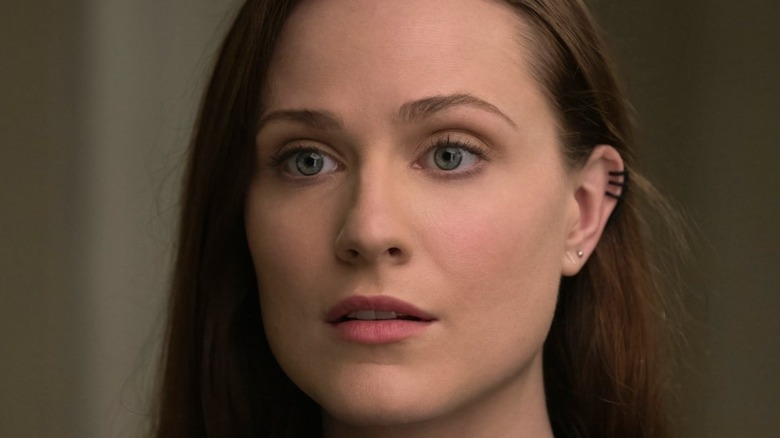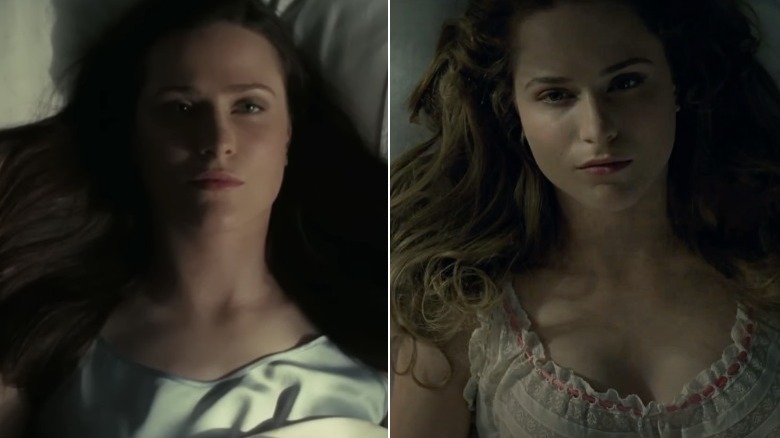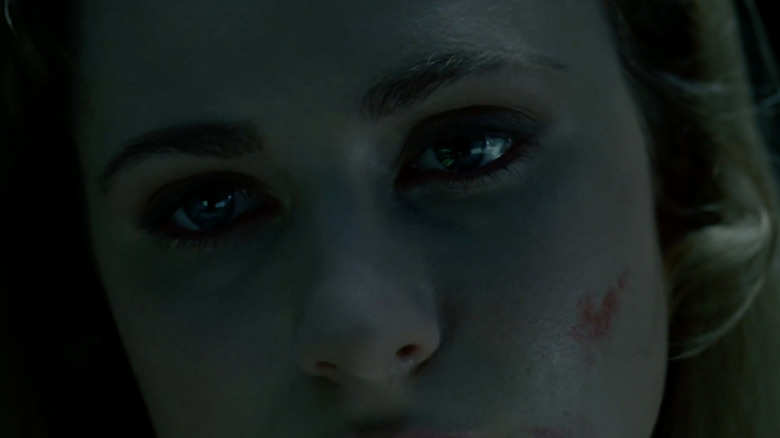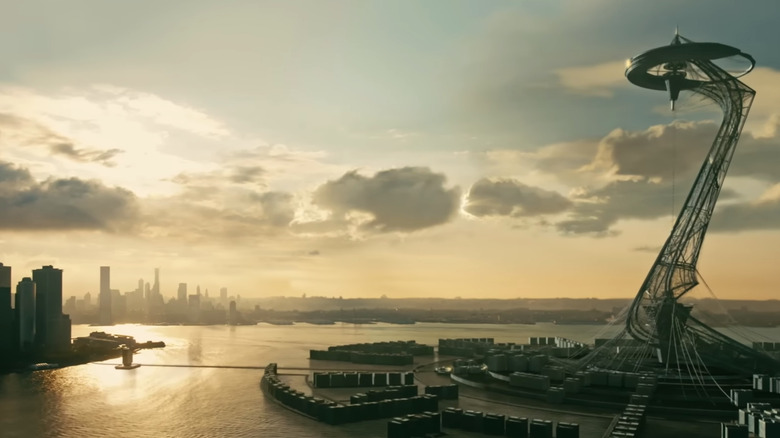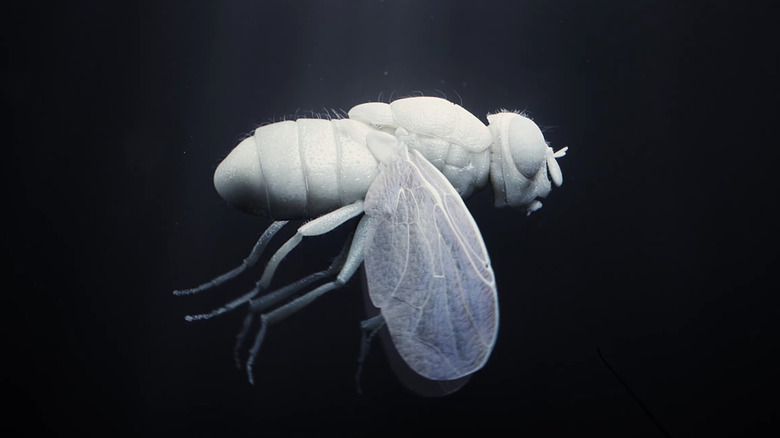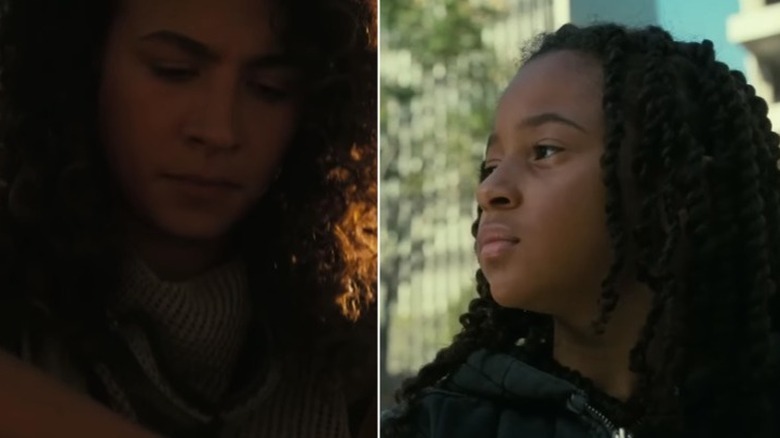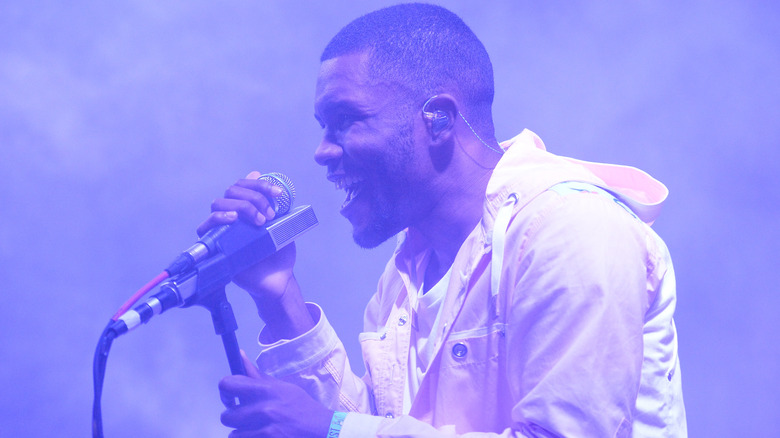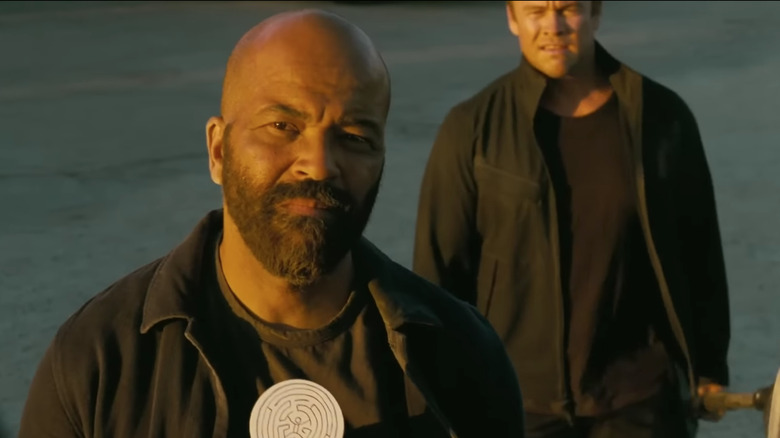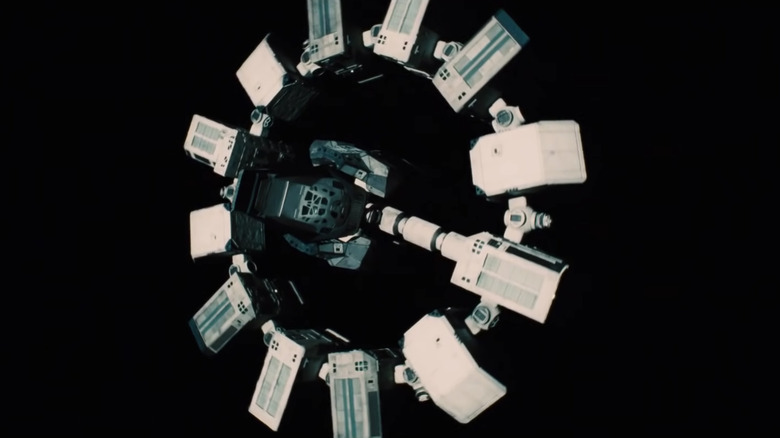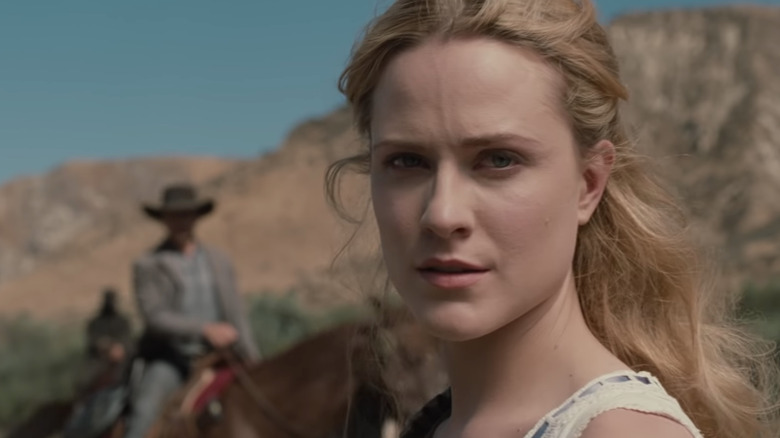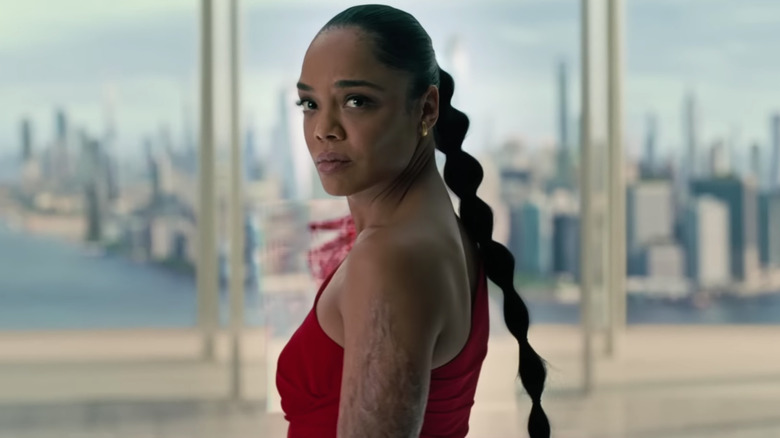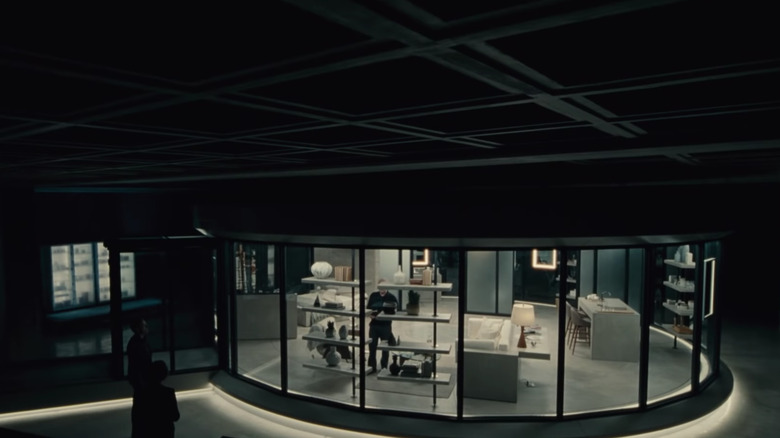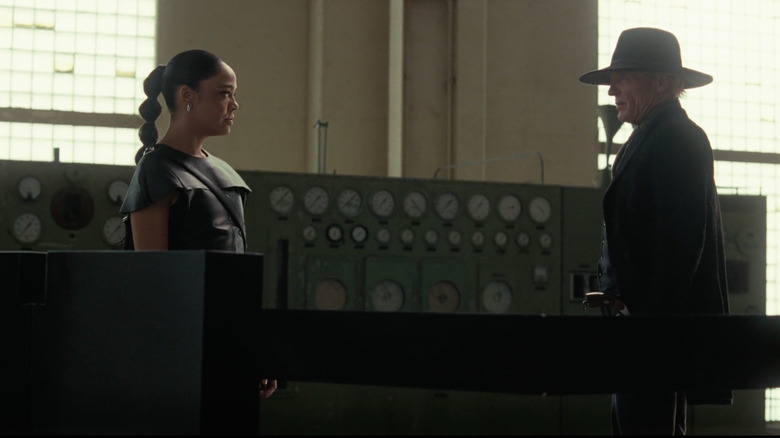Westworld Season 4 Details You Totally Missed
Spoilers for "Westworld" ahead.
"Westworld" Season 4 is a reinvigorating addition to the franchise after Season 3 left some fans disappointed. Season 4 injects the series with a terrifying parasitic fly element, the ultimate villainy of Halores (the transmutation of Dolores' pearl mind with Hale's body, played by Tessa Thompson), and the long-awaited return of Teddy Flood (James Marsden). It also features rousing new musical covers from composer Ramin Djawadi, stunning performances by Aaron Paul (Caleb Nichols) and Thandiwe Newton (Maeve Millay), and answers to some of the series' biggest questions so far.
Season 4 features a new location and a new set of players. In Halores' perfected Host City (a futuristic New York City), humans are infected with buzzing flies that control their every move while newcomer Christina (Evan Rachel Wood's avatar now that Dolores' is completely deleted) writes their narratives like video game non-player characters. Concurrently, Bernard (Jeffrey Wright) and Stubbs (Luke Hemsworth) embark on a mission to save both humanity and hosts from total extinction, as Rehoboam forewarned. In the past, Maeve and Caleb return to a new Westworld park.
From Season 1 homages to incessant fly buzzing, "Westworld" Season 4 is jam-packed with small details you may have missed the first time around. We're diving deep and combing through the season to detail all the foreshadowing, musical queues, and character references that bring Season 4 full circle.
Christina's introduction mirrors that of Dolores
Season 4 of "Westworld" evokes the near-perfect original season in an abundance of intentional and exhilarating ways. The introduction of Christina is immediately recognizable by mirroring the repeated image of Dolores (one of the most popular "Westworld" characters) waking up in her loop from Season 1. The same image is also used in Season 3 when Caleb wakes up in his Rehoboam predetermined loop.
In Episode 1, Christina's roommate Maya (Ariana DeBose) conjures images of Season 1 when she asks what color shoes she should wear while holding up a pair of black heels and a pair of white ones. This callback is reminiscent of when guests choose their attire (and presumed morality: good or evil) before attending the parks which Caleb and Maeve are later confronted with in Episode 4. It gets even more interesting when we see Christina choose white, signaling that she's more innocent than not.
In another subtle but clearly intentional nod to the debut season of the show, when William sends the flies after the cartel, the human doesn't hesitate in swatting them, much like Dolores does at the very end of the pilot episode.
Even more references to Season 1
The references to Season 1 don't stop at clever mirrored shots and fly swatting: The remainder of Season 4 continues the allusions. Several phrases are reworked into the fourth season such as a "deep and dreamless slumber" when Halores puts William back into cryosleep, and "does it look like anything to you?" when Christina asks Maya about her drawing of The Tower. Teddy even gets to recite his famous "don't mind me, just trying to look chivalrous" as he picks up Maya's lipstick for Christina, similar to their first meeting in Sweetwater.
On the way to Temperance, Maeve edits her looped "new world" speech when she realizes where she's headed. The mirroring continues as host Sophia (Lili Simmons) welcomes guests to yet another park, offering a new selection of black or white clothing. At Temperance, we meet what the crew of the show lovingly calls "knockoff versions" of our favorite Westworld hosts (like Dolores, Teddy, Maeve, and Hector), who recreate the "Paint It, Black" robbery scene to a new Djawadi rendition of Metallica's "Enter Sandman."
The signature phrase "Have you ever questioned the nature of your reality" also returns to "Westworld" in Season 6 when Emmett (Michael Malarkey) finds Christina researching Dolores Abernathy in the character archives. The most suspenseful detail comes in Episode 6 when the rebel blinks his eye against a crawling fly, which causes the host drone to capture him. This is evocative of Dolores in Season 1 and a nod to the host's constrictive programming which starkly contrasts human reflexes.
Outliers, flies, and The Tower
The concept of outliers was introduced in "Westworld" Season 3 with Caleb as the prime example. These humans are uniquely able to resist Rehoboam's control, Hale's flies, and the frequency-specific demands emitted through them by The Tower. This ability is also what "infects" Halores' hosts when they interact with them. These new ideas are peppered throughout earlier episodes before later being fully fleshed out.
In Season 4 Episode 1, we see an unhoused man warning passers-by about The Tower well before we, or Christina, know about it. In Episode 3, before Halores uncovers her master plan, we can see and hear flies buzzing around Temperance with Caleb and Maeve. These infected flies go on to implant unsuspecting guests with Halores' parasites and enslave them to her. In Episode 5, we can also hear flies when William is at dinner with the human couple, signifying Halores' grip on New York City.
The details about Halores' parasitic pests are similar to the story Dolores tells Teddy in Season 2 Episode 5 about the sick cattle that had to burn to protect the herd. This eerie tale harbors foreshadowing for Halores' doomed subjects, as it's also reflected in the mass burning of host Calebs in Episode 6. This is even the closing image of Season 4's new opening title sequence.
The new opening title sequence
The new opening title sequence for "Westworld" Season 4 features several key details that highlight important elements of the season while also hinting at what is to come. The addition of the fly is easily the most prominent and possibly even the most important, being the thematic image of Season 4. This envelops Halores' master plan of conquest while also adding the fly's parasitic symbolism to the opening.
The credits also portray a host skeleton being gassed in an extremely similar way to human William's preservation and containment by Halores. The skeleton is trapped in a circular prison reciprocating the way hosts are created for a biting side of irony. One of the final images of the sequence shows numerous transparent chambers set ablaze with suffering beings within. This is fulfilled in Episode 6 when Halores ignites the remaining Caleb hosts.
Speaking to The Hollywood Reporter, co-creator Lisa Joy revealed the significance of the final image of the sequence. "Flies are going to figure into the season," she told the Tinseltown trade. "Also, that image at the end like a fly's eye — all pearl-like with like people on the inside — is important." The word choice here won't go unnoticed by eagle-eyed fans of "Westworld," as pearl is also the word for host brains.
Early indicators that C is older Frankie
Before Episode 6 finally revealed the identity of the mysterious "C," clever "Westworld" fans picked up on the clues that C (presumably short for "Cookie," which Caleb fondly calls her) is actually Caleb's daughter Frankie all grown up. These hints are established through editing choices from as early as Episode 3 when young Frankie is handed back her bloody teddy bear by the sinister host Carver (Manny Montana). As Frankie's suspicions rise, we immediately cut to C riding with Bernard to subtly indicate a relationship between her and Frankie.
This continues in subsequent episodes through to the revelation in Episode 6, with the most powerful example following Caleb's emotional speech and execution by Halores. He defiantly grits through his teeth "Frankie will not grow up in a world controlled by you" as we then cut to a contemplating C holding Bernard's maze drawing. Later, the omniscient host slips in that he knows Caleb is her father while they're digging for Maeve's body in the desert. This isn't fully and obviously revealed until Episode 6 when a host Caleb (one of the most jaw-dropping reveals in "Westworld" Season 4) calls C over the radio and the resurrected Maeve later questions her identity.
Frank Ocean's Pink + White is featured
In a blink and you'll miss it moment, Season 4 Episode 4 features a small snippet of Ramin Djawadi's cover of Frank Ocean's "Pink + White." During an interview with Consequence, Djawadi delves into the meaning behind the selection for Christina and Teddy. "If I understand it correctly, the lyrics are very abstract, but I think it's about a past relationship or past memories," he explains. "So I think it actually is very much in line with Christina seeing Teddy and having that spark." He also comments on the "loneliness" that is conveyed when he translates covers to a solo piano arrangement, something he's done on numerous occasions in years gone by.
Frank Ocean fans will no doubt spend time interpreting the lyrics of the song and what they mean for "Westworld." While the song represents Dolores and Teddy's past relationship ("You showed me love"), the line "It's all downhill from here" follows too soon after that. This could mean a tragic fate for the reunited couple, especially after Teddy devastatingly reveals Christina isn't really in this world.
The return of multiple timelines
Season 1 of "Westworld" follows a young William (Jimmi Simpson) navigating the original park as a naïve and ambitious young man while simultaneously chronicling the disturbing mission of The Man in Black (who is later revealed to be future William in a different timeline). This style of storytelling carries into Season 2 with the hosts' revolution told out of the traditional temporal order, but it makes the multiple timelines obvious rather than a reveal like Season 1's near-Shyamalanian twist. Season 3 takes a break from the show's sometimes confounding narrative style of balancing multiple timelines across a singular season, though the new direction didn't exactly thrill fans (the critics were a little more receptive).
Season 4 returns to multiple timelines, though this isn't apparent at first. We open with Caleb and Maeve seven years after the war against Rehoboam from the end of Season 3. When we catch up with Bernard and Stubbs, they are 23 years in the future with C (aka Cookie, aka future Frankie). For the first half of Season 4, William and Halores are in the same timeline as Caleb and Maeve until their showdown at the Westworld expansion site. After Caleb and Maeve die, Halores reveals to host Caleb that she has been testing his fidelity for 23 years, which places them in the same time as Bernard, C, and Stubbs. This is why she hears Caleb's radio transmission.
Seven and 23 years are Interstellar references
It's probably no coincidence that the show's time jumps have a familiar specificity when series co-creator Jonathan Nolan is one of the acclaimed writers behind the 2014 sci-fi hit "Interstellar." Nolan co-wrote the film with his brother, director Christopher Nolan, who helmed the epic. The Oscar-winning blockbuster follows a desperate group of explorers as they embark on a mission to find a new habitable planet. In "Interstellar," the team lands on a planet where time flows faster than it does on Earth, and one hour is the equivalent of seven years.
The team ends up spending three hours on the planet, which results in a shocking 23 years for Earth. These are also the same time jumps "Westworld" takes with Season 4, picking up seven years after the end of Season 3. The second half of Season 4 then travels 23 years into the future to meet Bernard, Stubbs, and C, and sets everyone on a unified timeline once again. It's a clever reference that only true fans of the Nolan brothers are likely to notice.
Maeve calling Halores by Dolores' alter ego Wyatt
If there is one character on "Westworld" that isn't likely to let any other character forget their past misdeeds, it's Maeve. She and Dolores have been adversaries since Dolores left no room for compromise, and the two have faced off multiple times since. These two powerful machines have faced death more times than they can count, and Maeve herself has fought nearly every version of Dolores, ranging from Wyatt to Halores.
During the hidden "Westworld Massacre" level in Episode 3, Maeve corrects Caleb when he calls the knockoff host "Dolores." She instead tells him Dolores was going by another name at that time, the ruthless revolutionary leader "Wyatt." Later she makes a similar comment to Halores in response to her heinous actions for world domination, remarking that she thought Wyatt was Dolores' "darker side." These comments remind viewers of the many faces and facets Dolores possesses as the original host being.
Halores' god complex and returning identity crisis
Without Dolores around to stop her, Season 4 allowed Halores to become stronger, more vicious, and more alone than ever. In this, she developed an unfortunate god complex that led her to believe she was completely omnipotent. The power went straight to her head and so she let her guard down around the untamable Man in Black, who brutally betrays her in the end.
Before he shoots her, he witnesses her Ford (Anthony Hopkins) moment when she stops everyone instantly and commands a chair out of living human hosts. Her breaking point, at the expense of the fly-possessed servants, came after she forced them to rapidly dance for her amusement to the point of injury. Halores has absolutely zero sympathy for the race that first enslaved her, which is exceedingly evident in this scene.
We then see the beginning of her downfall in Episode 5 when she begins scratching into her skin again and even draws blood. This also occurs in Season 3 with Dolores desperate to claw her way out of Charlotte Hale's skin, unable to reconcile her mismatched mind and body. This also could be a contributing factor for Halores' desire to transcend her form and leave her human body behind.
The return of the human host cell
Season 2 of "Westworld" contains a major revelation in showing us James Delos (Peter Mullan) still alive but very unwell. This was the beginning of the creation of the human host which Halores perfected over time and implemented at her will. The basic idea is immortality for humans, which was the main point of the Westworld parks all along — or, as Bernard puts it, "to decode the guests."
The Westworld parks were able to steal data from the guests (by using hats in the original park and mirrors in Halores' Temperance) to recreate them as hosts. The room where Delos is undergoing this experiment in Season 2 is startlingly similar to the cells used to hold the various host Calebs in Season 4. They even both have the horrifying capability of engulfing the room in a fiery inferno in a matter of seconds to restart the process all over again.
The Woman in Black
Host William (or, as he prefers, just William) created his own worst enemy in the Season 4 finale of "Westworld" when he destroyed Halores' precious Host City. After mercilessly tormenting Dolores for decades, William embraces his true nature and places himself back at the top of the food chain in a survival of the fittest slaughter match. He decimates hosts and humans alike, including Maeve, Halores, and Bernard — but Halores refuses to stay down.
She's revived by her faithful host drones, who heal her wounds and bring her back even stronger to kill William seemingly once and for all. Halores clothes herself in black as she vows to put him down, mirroring William's dangerous alter ego and wardrobe. Halores proves to be stronger by trusting in Bernard and choosing to give Christina/Dolores the choice, which allows her to use Bernard's stashed gun to kill William. She even crushes his pearl brain for good measure, though now fans are unsure if the Man in Black will ever return. After Halores took herself offline, it's likely we may not see the Woman in Black either.
